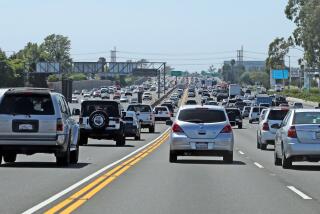Increase in Speeders Could Cost State $30 Million in U.S. Funds
- Share via
The number of Californians exceeding the 55-m.p.h. speed limit is increasing and, if the trend continues, the state could lose $30 million a year in federal money for highway construction, state officials said Thursday.
That warning came in the wake of an announcement in Washington that the federal Department of Transportation plans to dock Arizona and Vermont a total of $7 million and that California could be among the next to feel the sting of Washington’s 55-m.p.h. enforcement campaign.
Figures released in Washington on Wednesday and confirmed in Sacramento on Thursday show that nearly half of California’s motorists exceed the speed limit. California ranks seventh in non-compliance with the limit, federal officials said, behind Arizona, Rhode Island, Vermont, New Hampshire, Nevada and Michigan.
Arizona and Vermont were targeted Wednesday by Transportation Secretary Elizabeth Hanford Dole, who said she had notified the governors of those states that they face a loss of highway money because more than 50% of motorists in each of the two states exceed the limit. Arizona has a 56.4% non-compliance rate; Vermont’s is 53.2%.
California’s non-compliance figure stands at 49.7%, and state officials fear that it will top 50% by year’s end.
“The speeds have been creeping up,” said Caltrans spokesman Gene Berthelsen, “and it could be us (facing federal sanctions) in a year or so.”
Not Much Hope
Berthelsen said the penalty “could be as much as $30 million,” and neither he nor other state officials contacted Thursday offered much hope that the penalty could be avoided.
“We believe the California Highway Patrol is doing everything it can to keep the state in compliance, but writing 1 million tickets a year for speeding isn’t stopping the trend,” Berthelsen said.
That feeling was echoed by CHP spokesman Steve Kohler, who said, “I don’t think there is any earthly way possible we can do that (keep the rate below 50%). . . . We’re at the limits of our capability now, with a uniformed staff of about 5,000 officers.”
Any effort to increase the number of highway patrolmen on the roads might cost the state more then the penalty federal officials impose, said Steve Schnaidt, consultant to the state Senate Transportation Committee. Schnaidt said that when the CHP increased its numbers by 700 officers several years ago, the budget increase for pay and support services was more than $35 million annually.
The feared $30-million-a-year loss is a small sum when compared to Caltrans’ 1986-1987 budget of $2.96 billion ($1.4 billion of which is federal money), but to simply ignore the loss in federal funds would make a bad situation worse, Schnaidt said.
The federal money in question is actually taken out of the pocketbooks of Californians in the form of the federal gasoline excise taxes.
“It’s our money,” Schnaidt said, “it’s generated here.”
California pays more into the gasoline tax pool than it gets back, he explained. The return to the state is about $100 million a year less than California drivers pay. Another $30 million loss would make the imbalance just that much worse, Schnaidt said.
By federal law, states must monitor speed-limit compliance and supply the U.S. Department of Transportation with compliance figures generated by highway sensors. There are 108 sensors on freeways and state highways around California, according to Berthelsen.
In recent years, Caltrans and the CHP, while emphasizing the need to enforce the 55 m.p.h. limit, have suggested that there is more to highway safety than strict speed limits.
“We believe that it’s very important that people maintain a uniform speed and that uniformity of speed is a primary factor in highway safety,” Berthelsen said.
Caltrans and the CHP, as a result of a joint study requested by the Legislature, recommended last February that the speed limit for cars be increased to 65 m.p.h. along interstate highways outside metropolitan areas.
More to Read
Sign up for Essential California
The most important California stories and recommendations in your inbox every morning.
You may occasionally receive promotional content from the Los Angeles Times.










